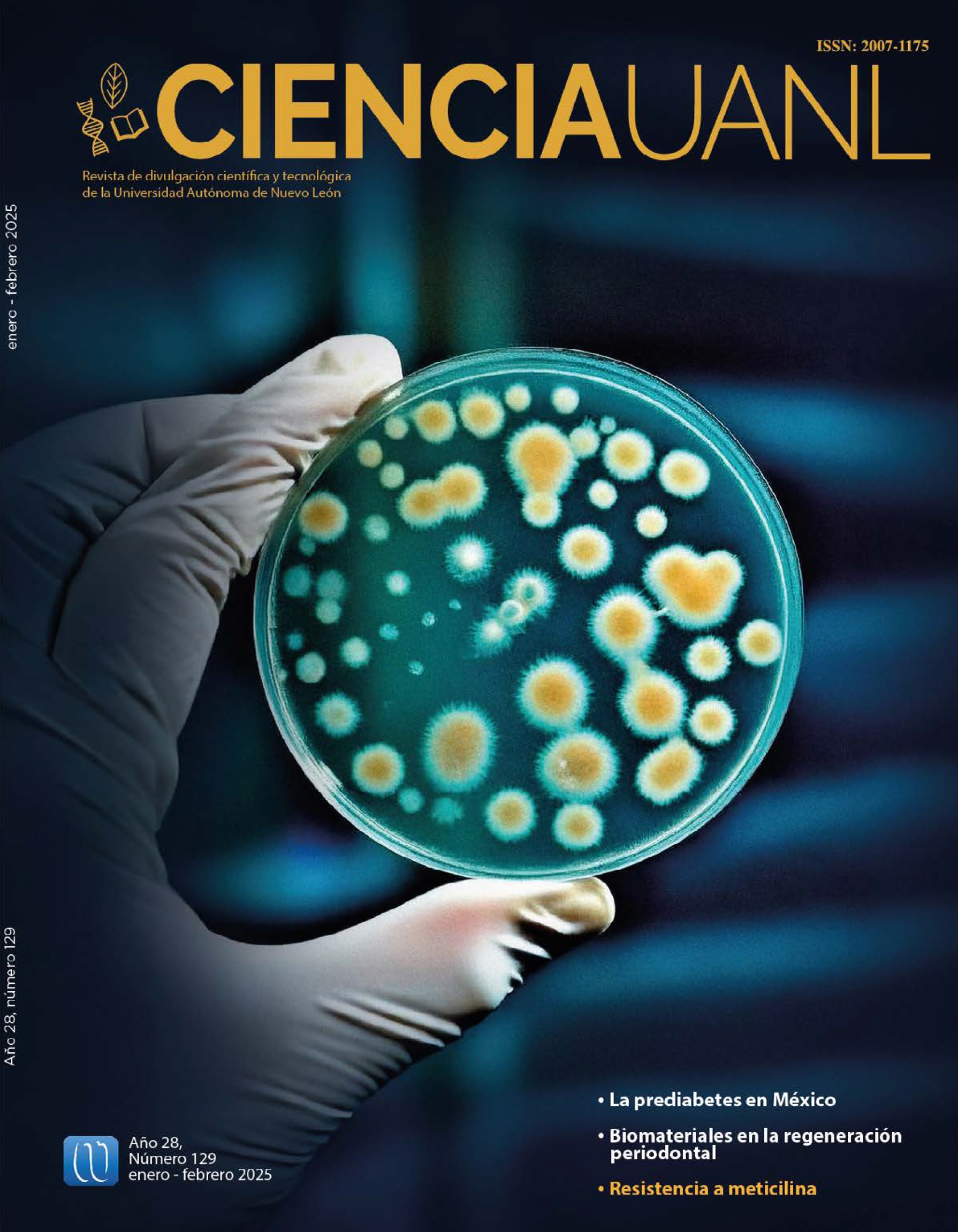Una lección de microbiología a lo largo de la historia: la resistencia a meticilina
DOI:
https://doi.org/10.29105/cienciauanl28.129-4Palabras clave:
resistencia, β-lactámicos, Staphylococcus aureus, penicilina, meticilinaResumen
La resistencia a los antimicrobianos es un grave problema mundial, ya que implica la pérdida de la efectividad de los tratamientos contra enfermedades infecciosas. Con el descubrimiento de la penicilina se inició una época en la que se pensó se podría luchar de manera efectiva contra las enfermedades infecciosas; no obstante, dicha época no duró mucho tiempo. Así sucedió con la meticilina, un antibiótico β-lactámico semisintético introducido al área clínica en 1959; sin embargo, la resistencia a esta nueva opción terapéutica se registró en 1960.
Descargas
Citas
Bouchami, Ons, Ben Hassen, Assia, De Lencastre, Herminia, et al. (2012). High prevalence of mec complex C and ccrC is independent of SCCmec type V in Staphylococcus haemolyticus, European Journal of Clinical Microbiology & Infectious Diseases: Official Publication of the European Society of Clinical Microbiology, 31(4), 605-614, https://doi.org/10.1007/s10096-011-13543 DOI: https://doi.org/10.1007/s10096-011-1354-3
Bush, Karen, y Bradford, Patricia. (2016). Beta-Lactams and beta-Lactamase Inhibitors: An Overview, Cold Spring Harb Perspect Med, 6(8),. https://doi.org/10.1101/cshperspect.a025247 DOI: https://doi.org/10.1101/cshperspect.a025247
Hamilton-Miller, Jeremy. (2008). Development of the semi-synthetic penicillins and cephalosporins, Int J Antimicrob Agents, 31(3), 189-192, https://doi.org/10.1016/j.ijantimicag.2007.11.010 DOI: https://doi.org/10.1016/j.ijantimicag.2007.11.010
Harkins, Catriona, Pichon, Bruno, Doumith, Michel, et al. (2017). Methicillin-resistant Staphylococcus aureus emerged long before the introduction of methicillin into clinical practice, Genome Biol, 18(1), 130, https://doi.org/10.1186/s13059-017-1252-9 DOI: https://doi.org/10.1186/s13059-017-1252-9
Hartman, Barry, y Tomasz, Alexander. (1984). Low-affinity penicillin-binding protein associated with beta-lactam resistance in Staphylococcus aureus, J Bacteriol, 158(2), 5135-16. DOI: https://doi.org/10.1128/jb.158.2.513-516.1984
Katayama, Yuki, Zhang, Hong-Zhong, Hong, Dong, et al. (2003). Jumping the Barrier to bLactam Resistance in Staphylococcus aureus, J Bacteriol, 185(18), 54655- 472, https://doi.org/10.1128/jb.185.18.54655-472.2003
Katayama, Yuki, Zhang, Hong-Zhong, Hong, Dong, et al. (2003). Jumping the Barrier to b-Lactam Resistance in Staphylococcus aureus, J Bacteriol, 185(18), 54655- 472, https://doi.org/10.1128/jb.185.18.54655-472.2003 DOI: https://doi.org/10.1128/JB.185.18.5465-5472.2003
Lobanovska, Mariya, y Pilla, Giulia. (2017). Penicillin’s Discovery and Antibiotic Resistance: Lessons for the Future? Yale J Biol Med, 90(1), 135-145, PMID: 28356901; PMCID: PMC5369031.
Rolinson, George, y Geddes, Alasdair. (2007). The 50th anniversary of the discovery of 6-aminopenicillanic acid (6-APA), Int J Antimicrob Agents, 29(1), 3-8. https://doi.org/10.1016/j.ijantimicag.2006.09.003 DOI: https://doi.org/10.1016/j.ijantimicag.2006.09.003
Sauvage, Eric, Kerff, Fréderic, Terrak, Mohammed, et al. (2008). The penicillin-binding proteins: structure and role in peptidoglycan biosynthesis, FEMS Microbiol Rev, 32(2), 234-258, https://doi.org/10.1111/j.1574-6976.2008.00105.x DOI: https://doi.org/10.1111/j.1574-6976.2008.00105.x
Wisplinghoff, Hilmar, Rosato, Adriana, Enright, Mark, et al. (2003). Related clones containing SCCmec type IV predominate among clinically significant Staphylococcus epidermidis isolates, Antimicrob Agents Chemother, 47(11), 35743-579, https://doi.org/10.1128%2FAAC.47.11.35743-579.2003
World Health Organization. (2023). Antimicrobial resistance, https://www.who.int/news-room/factsheets/detail/antimicrobialresistance#:~:text=As%20a%20result%20of%20drug,severe%20illness%2C%20disability%20and%20death
Zapun, André, Contreras-Martel, Carlos, y Vernet, Thierry. (2008). Penicillin-binding proteins and beta-lactam resistance, FEMS Microbiol Rev, 32(2), 3613-85, https://doi.org/10.1111/j.1574-6976.2007.00095.x DOI: https://doi.org/10.1111/j.1574-6976.2007.00095.x






